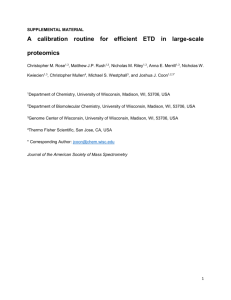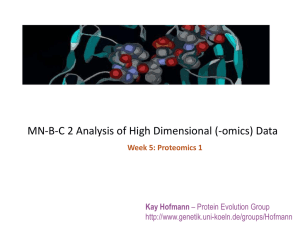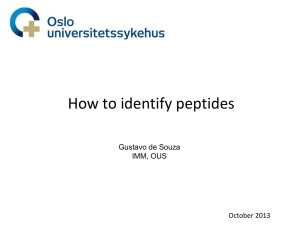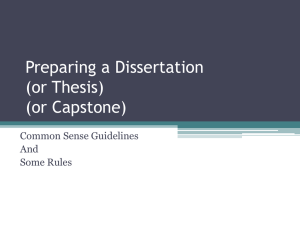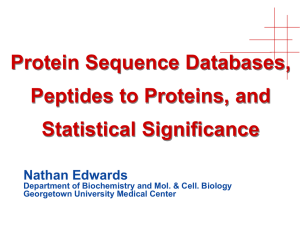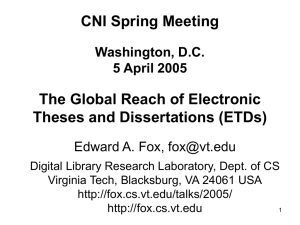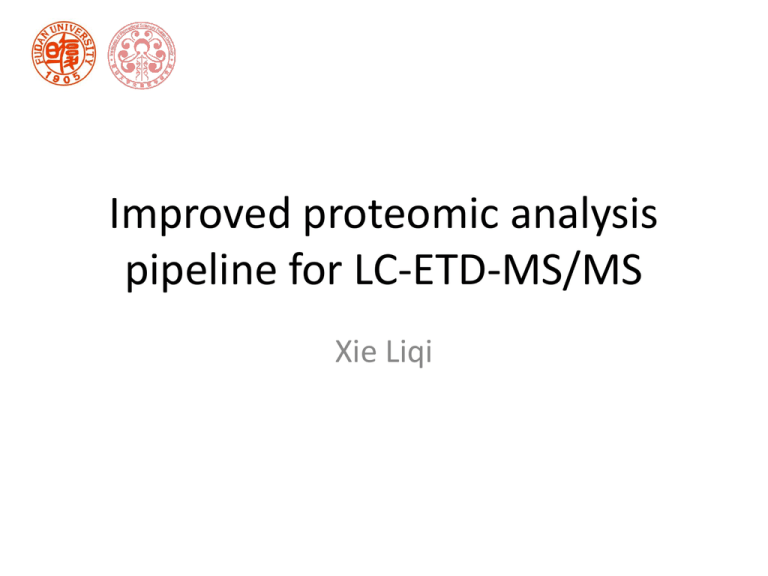
Improved proteomic analysis
pipeline for LC-ETD-MS/MS
Xie Liqi
Fragmental pattern of Protein
backbone in MS
•
b, y products are formed by the
lowest energy backbone
cleavage of protein ions.
•
c, z cleavage occurs between
almost any combination of
amino acids, except for cyclic N
of Pro.
•
radical site reaction based c, z
cleavage require less energy
than b, y cleavage.
International Journal of Mass Spectrometry (1999) 787–793
2
Common dissociation techniques
CxD
Collision-induced dissociation (CID), also known as
collisionally activated dissociation (CAD). Molecular ions
are collided with inert gas molecules, causing the ions to
fragment into smaller pieces: b/y ions.
ExD
Electron capture dissociation (ECD) and Electron transfer dissociation (ETD). Soft
fragmentation technique that can generate a complete series of ions and preserve
neutral and labile groups, hence, it provides better sequence coverage : c/z ions
ECD: uses low-energy electrons to fragment molecular ions. FT-MS
ETD: uses free radical anions to fragment molecular ions.
ExD produce complimentary sequence to CxD
3
Electron Transfer Dissociation
Anion attachment
Proton transfer
• Anions were used as vehicles for electron delivery to multiply-protonated
peptides in ion trap mass spectrometry.
International Journal of Mass Spectrometry (2004) 33–42
4
•
•
•
•
•
•
•
Strong
Enhanced protein identification and sequence coverage using bottom-up approaches
Improved identification of the location of PTM
Enhanced MS/MS of basic peptides and proteins such as histones
Much improved MS/MS of large peptides and proteins
Weak
ETD fails to identify larger amounts of peptides than CID, although it provides higher
sequence coverage.
Insufficient fragmentation especially for 1+ and 2+ ions: High-intensity unreacted
precursor and electron transfer no dissociation (ETnoD) products.
ETD – centric search algorithms. Commonly used search algorithms were designed
and trained for CID data of tryptic peptides.
5
To improve ETD identification:
•
ETD fragmentation efficiency can be improved by increasing peptides’ charge state.
– Use proteases which generated longer peptides (etc. Lys C, Arg C)
– chemically modifying the peptides to make them carry more charges or become more basic.
– adding small amounts of compounds with low-volatility and high surface tension to ESI
solution.
• Optimized search algorithms
– Consider other ion types other than c, z’-ions.
– Remove additional ETD specific features: peaks belonging to precursor, ETnoD products and
neutral loss species.
– Design ETD applicable score standards (Peaks 5.1)
– Accurate prediction charge state of precursor ions.
6
Supper charge reagent
Applying high surface tension, low relative
volatility solvents could shift the ESI charge
state distribution (CSD) to higher charge.
Anal. Chem. 2007, 79, 9243-9252
7
Dimethylation and guanidinationof doubly charged Lys-N peptides resulted in a
significant increase in peptide sequence coverage of ETD sequences.
Anal. Chem. 2009, 81, 7814–7822
8
To improve ETD identification:
•
ETD fragmentation efficiency can be improved by increasing peptides’ charge state.
– Use proteases which generated longer peptides (etc. Lys C, Arg C)
– chemically modifying the peptides to make them carry more charges or become more basic.
– adding small amounts of compounds with low-volatility and high surface tension to ESI
solution.
• Optimized search algorithms
– Consider other ion types other than c, z’-ions.
– Remove additional ETD specific features: peaks belonging to precursor, ETnoD products and
neutral loss species.
– Design ETD applicable score standards (Peaks 5.1)
– Accurate prediction charge state of precursor ions.
9
The frequencies of different fragment ion types in ETD data
ZCore searches for a’-, y-, c- and z’-ions.
pFind & X!Tandem takes into account the
hydrogen-rearranged fragment ions to
identify 63–122% more non-redundant
peptides.
W.S.Noble developed precursor charge
state prediction for ETD Spectra
Peaks 5.1 proposed the generating function
approach (MS-GF) to design ETD-specific
scoring function
Removal of additional ETD specific features via spectral processing
increased total search sensitivity by 20% in Coon’s paper.
10
To improve ETD identification:
•
ETD fragmentation efficiency can be improved by increasing peptides’ charge state.
– Use proteases which generated longer peptides (etc. Lys C, Arg C)
– ofchemically
modifying the
peptides to
make
them
carry
more charges
or become
more basic.
Most
charge enhancing
techniques
have
not
been
applied
to complex
biological
samples.
The small
mostamounts
adaptable
techniquewith
for ETD
based peptide
is unclear.
– adding
of compounds
low-volatility
and highsequencing
surface tension
to ESI
solution.
• Optimized search algorithms
– Consider other ion types other than c, z’-ions.
– Remove additional ETD specific features: peaks belonging to precursor, ETnoD products and
Systemneutral
comparison
between ETD-centric optimized search algorithms is needed.
loss species.
– Design ETD applicable score standards (Peaks 5.1)
– Accurate prediction charge state of precursor ions.
11
To find the optimal combination of charge enhancing
methods and database search algorithms for ETD analysis
Complex sample
Charge enhancing method:
Dimethylation, Guanidination.
Add 0.1% m-NBA in ESI Solution
Lys-C Digestion
Standard protein
Multi-algorithms Database Search
Mascot ,Sequest, OMSSA, pFind, X!Tandem
12
Chemical labeling of tryptic BSA peptides
画+28的峰+42的峰
oringinal
Dimethylation
+28KD
Increased ion intensity
High reaction efficiency
Guanidinylation
+42 KD
+42KD
A few byproduct
13
Peptide charge-state increment with chemical labeling
and m-NBA treatment (Simple sample)
GRAVY
Untreated
-0.14
Dimethylation Guanidinylation
0.17
0.08
m-NBA
-0.2
pI
5.33
6.04
5.74
5.18
( -)%
14.40
11.00
8.60
15.50
(+)%
11.20
8.00
7.50
11.20
Average Charge
2.12
2.06
2.10
2.64
Average Length(aa)
10.80
11.20
10.84
11.05
Sequence Coverage(%)
35.58
27.68
36.08
38.06
• 20% guanidinylated and 50% of peptides in m-NBA containing solvent displayed increased
charge, dimethylation seemed irrelevant to ion charging.
• Both m-NBA or chemical labeling experiments increase spectra complexity.
• m-NBA treated peptides got the highest ion charge and sequence coverage.
14
Speculated mechanism of m-NBA
induced charge enhancement
Real-time surface tension are correlated with charge state by
peptide length (Z/L) dynamic during LC gradient.
15
Charge enhancing ETD analysis of
AMJ2 cell line (complex sample)
LCnoD :Lys-C digestion without further derivatization
TynoD :trypsin digestion without further derivatization
TyNBA :trypsin digestion and m-NBA treatment
Highly Charged ions increase in an order of
TynoD < TyNBA < LCnoD
m-NBA could enhance
ion charging in complex
biosystems.
16
Quality control of LC replication
No.MS
/MS
No.MS
peaks
Total ion
intensity
TyNBA
6599
6688
6744
2819310
2776604
2778265
2.895e+10
3.028e+10
3.087e+10
TynoD
6187
6191
6060
2570170
2619559
2690441
1.670e+10
1.693e+10
1.576e+10
LysC
5682
5597
5685
3705791
3640280
3596867
1.223e+10
1.208e+10
1.191e+10
Retention time
Peak area
Replicates of TyNBA data
Nonlinear Progenesis LC-MS
17
TyNBA
TynoD
18
TIC of TyNBA & TynoD
Retention time
Blue lies indicate mass peaks with different retention time between TyNBA and TynoD
m/z
Retention time of different types of peptides has been changed by m-NBA
19
• Working environment of search algorithms
Name
Author or Co. LTD
Vision
Format
2V software
MASCOT
Matrix Science, Westminster, UK
2.3.0.2
dat
Scaffold3
SEQUEST
Thermo Scientific,USA
v.22
srf
Scaffold3
pFind
ICT-CAS, Beijing, China
2.6
txt
pBuild
X!Tandem
The Global Proteome Machine
Organization
CYCLONE
xml
2010.12.01
Scaffold3
OMSSA
The National Library of Medicine
2.1.9
OMSSA Parser
omx
20
Establishing thresholds for peptide identifications
• Compute individual FDR for all charge states:positive matches with
higher charge states tended to receive higher scores than false hits.
• chose peptide spectrum match (PSM) to be the only identification
criterion to avoid bias in protein assembling.
Mascot
21
Establishing thresholds for peptide identifications
using charge dependent FDRS
Sequest
22
Establishing thresholds for peptide identifications
using charge dependent FDRS
OMSSA
23
Establishing thresholds for peptide identifications
using charge dependent FDRS
X!Tandem
24
Establishing thresholds for peptide identifications
using charge dependent FDRS
pFIND
25
Discrepancy between different algorithms
• There was a great discrepancy between different algorithms in
identification of doubly charged PSMs.
• OMSSA and sequest had quite low amounts of doubly charged PSMs.
• pFind and X!Tandem (considering c+H, z-H) had a significant advantage of
2+ peptide identification over all algorithms.
26
additional ETD
specific features :
precursor, charge
reduced products and
neutral loss species
hydrogen-rearranged
fragment ions.
ETD spectra of doubly (A), triply (B) and quadruply (C) charged “K.QEYDESGPSIVHRK.C”.
27
Search algorithms exhibited distinctly for
identifying differently charged peptides
High charge
2+ ions
28
X!Tandem and pFind performed well in all strategies
Top three search optimal search algorithms for each strategy
Combining pFind and
X!Tandem results can cover
92.65% of all identifications
29
Successful identification rate (pFind + X!Tandem)
of Amj2 data
2+
3+
4+
Overall
Spectra No.
13090
4258
502
17850
Spectra No.(FDR<5%)
7012
2002
109
9123
Successful Identification (%)
53.57
47.01
21.7
51.11
Spectra No.
13581
5245
787
19506
Spectra No.( FDR<5%)
7118
2036
125
9279
Successful Identification (%)
52.41
38.81
15.88
47.57
Spectra No.
8725
5304
1722
15751
Spectra No.( FDR<5%)
4271
2323
364
6958
Successful Identification (%)
48.95
43.8
21.14
44.17
Trypsin
m-NBA
Lys-C
Achieved ~ 50% successful identification
Interpretation of ETD spectra from > 4 + ions remain a challenge.
30
Physical and chemical properties of AMJ2 data
TynoD
TyNBA
LCnoD
2.22/2.30
2.27/2.35
2.35/2.63
13.1
13.51
13.6
-0.044
-0.069
-0.251
Average pI
4.91
4.62
6.02
(positively charged residue)%
11.9
11
14.6
(negatively charged residuw)%
13.3
13.7
14.3
Average Charge (identified/all)
Peptide length
Average GRAVY Score
ETD probably optimal for dissociation of 13-14 aa peptides.
31
Improvement of peptide identification by
combined LCnoD and TyNBA strategy
• Large difference and great synergy between Lys-C and m-NBA strategies
on a peptide level.
32
Conclusion
Complex sample
Charge enhancing method:
Dimethylation, Guanidination.
Add 0.1% m-NBA in ESI Solution
Lys-C Digestion
Standard protein
Multi-algorithms Database Search
Mascot ,Sequest, OMSSA, pFind, X!Tandem
Charge enhancing methods (m-NBA etc.) could increase
spectra number and identification efficiency of ETD data.
Combined pFind and X!Tandem search could greatly improve
ETD identification.
33
Problem:Identify high charge peptide
0.5
0.45
Charge distribution of PMF
0.4
0.35
0.3
0.25
0.2
0.15
0.1
0.05
0
1
2
3
trypsin
1.
4
mnba
5
6
>=7
lysc
The higher the charge ,the lower the intensity of zero isotope peak.
Miss Match
34
Problem:Identify high charge peptide
2. Complex MSMS spectra with low match property.
3. Most search algorithms mainly recognize 1+ and 2+ fragmental ion,
Wildly used mass analyzer has mass range limitation (typically lower than 2000 U)
35
36




